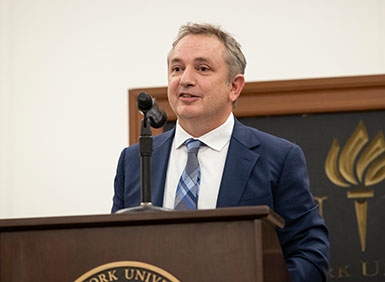In Madison Lecture, Judge David Barron explores how judges look to both the past and the future
On October 24, Chief Judge of the US Court of Appeals for the First Circuit David Barron delivered the 54th James Madison Lecture, discussing how judges take the court of history into account. He explored how judicial decisions can be affected by the “court of history past”— all that happened before a present-day decision —and by the “court of history future”—how Americans are likely to view a decision made now in years to come. Discussing judicial originalism, Barron acknowledged the importance of rooting judgments in history, but also noted the limitations of looking backward: “Predicting the future is sometimes easier than discerning the past.”
Watch video of the James Madison Lecture:
Selected remarks by Chief Judge David Barron:
“The literary critic Harold Bloom famously argued that strong poets are plagued by the anxiety that they are merely rewriting the poems that were already written. And to assuage what he called ‘the anxiety of influence,” he argued that these poets creatively misread what came before them to claim their creativity for posterity. Judges are hardly poets—indeed they are obliged to respect precedent …[but] judges at all levels of the judicial system are quite aware that if the stakes of the case are high enough, history may come to judge their decisions harshly, no matter how faithful to the past the decision may have been…. Judges turn out to be no more immune from the ‘anxiety of influence’ than poets, for they too have reason to worry about past’s grip on them whenever they have discretion to make a choice.” (video, 11:10)
“Sophisticated defenders of originalism no longer assert that the method’s virtue inheres in the easy-to-access answers that it supplies...Just as there is risk in judging based on forecasts of what is to come, there is risk in judging based on assessments of what has already been.... If the forward-looking judge risks imagining a future in the judge’s own pro-progress image, the backward-looking judge risks adhering to a narrow view of the past out of the judge’s own commitment that change must be resisted.” (video, 51:17)
Posted on November 15, 2022; updated on September 1, 2023


